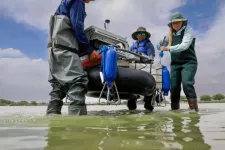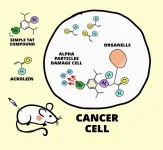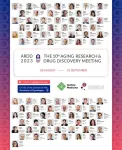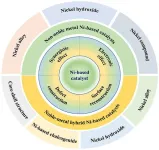(Press-News.org)
EL PASO, Texas (June 27, 2023) – Step aside self-driving cars, self-driving boats are here — and they can do more than take you on a cruise.
Researchers at The University of Texas at El Paso have constructed a fully autonomous boat that can carry out bathymetric surveys — surveys of the depth and terrain of bodies of water like oceans, rivers and lakes. The team hopes the robotic boat can help simplify the survey process, which usually takes a crew of individuals to complete, as well as assist with reconnaissance missions.
The boat and its capabilities are described in the May issue of the journal Sensors.
“There are lots of reasons scientists carry out bathymetric surveys,” said Laura Alvarez, Ph.D., lead author of the study. “If you want to work in water-related studies, you need to know the shape and landscape of bodies of water. For example, you might want to map a reservoir to learn about water supply for electrical demand, or a river to learn about river evolution or flow patterns.”
Alvarez, an assistant professor in UTEP’s Department of Earth, Environmental and Resource Sciences, specializes in unmanned systems for earth science. She started developing the boat several years ago but needed help tweaking and perfecting the system.
That’s when she recruited science and electrical engineering master’s student Fernando Sotelo ‘22.
“The first time we tested the boat was at the swimming pool at UTEP — just to make sure it could float,” laughed Fernando Sotelo, study co-author and now UTEP alumnus.
Over the course of a year, Sotelo refined the aluminum watercraft, a 3-foot-by-3-foot circular craft that rests on a thick black inner tube, testing it in various environments like New Mexico’s Grindstone and Elephant Butte lakes.
His goals included extending the boat’s hours of operation and reliability; and making it fully autonomous and responsive to potential environmental issues like wind speed and temperature flux. Now, a failsafe can detect when batteries are low or wind gusts are too high and triggers a return-to-base function.
The rudderless watercraft operates with four thrusters, allowing it to travel up to 5 feet per second and easily rotate 360-degrees. A solar panel and lithium battery allow the boat to last up to four hours at sea — covering an area up to 472,400 square feet.
All the while a multibeam echosounder — a sonar system — emits sound waves from the bottom of the boat. Water depth can be calculated by the time it takes for the sound wave to water to hit the seafloor and return to the sonar system. The sound itself that returns to the device can help detect the type of material on the seafloor.
To show proof of concept, the team successfully created 2D and 3D maps of portions of Ascarate Lake in El Paso, Texas and Grindstone Lake in Ruidoso, New Mexico.
“My goal was to make the boat state-of-the-art and I think I did that. Of course, there’s always room to improve,” said Sotelo, who worked on the boat for his master’s thesis. “But the system works and for now, I hope it can make it easier for scientists like Dr. Alvarez to conduct their research.”
Alvarez will put the boat to use for the first time this summer to study the Rio Grande River’s flow and depth.
She adds that the instructions to replicate the boat are online in their latest Sensors publication.
“The reason we wrote the paper was so that anyone can reproduce it by themselves,” Alvarez said. “It serves as an effective guideline to get them started.”
About The University of Texas at El Paso
The University of Texas at El Paso is America’s leading Hispanic-serving University. Located at the westernmost tip of Texas, where three states and two countries converge along the Rio Grande, 84% of our 24,000 students are Hispanic, and half are the first in their families to go to college. UTEP offers 169 bachelor’s, master’s, and doctoral degree programs at the only open-access, top-tier research university in America.
END
Researchers led by Katsunori Tanaka at the RIKEN Cluster for Pioneering Research (CPR) in Japan and Hiromitsu Haba at the RIKEN Nishina Center for Accelerator-Based Science (RNC) have developed a new technique that has the potential to generically treat several kinds of cancer, with fewer negative side effects than currently available methods. Published on June 27 in Chemical Science, the proof-of-concept study showed that tumors in mice grew almost three times less and survival was 100% after just one injection of a compound that is designed to emit small amounts of alpha radiation from the inside of cancer cells, thus killing them but sparing ...
In October, the excavation work for the superlative construction project began. What some consider an ideal ecological city, others call a promotional gimmick. Researchers from the Complexity Science Hub now show why The Line should not be a showcase for future cities.
"It's the embodiment of the dream to start from scratch and completely rethink a city," says Rafael Prieto-Curiel, who researches cities at the Complexity Science Hub. The Line is planned to be a city built from nothing in the desert. It is to consist of two gigantic, unbroken rows of skyscrapers, with living space in between. 170 kilometers long. 200 meters wide. 500 meters high, higher ...
Magnetotactic bacteria, which can align with the Earth’s magnetic field, have been discovered in a new location. Previously observed on land and in shallow water, analysis of a hydrothermal vent has proven that they can also survive deep under the ocean. The bacteria were able to exist in an environment that was not ideal for their typical needs. Magnetotactic bacteria are of interest not only for the role they play in Earth’s ecosystem, but also in the search for extraterrestrial life. Evidence of their existence can remain in rocks for billions of years. Their magnetic inclinations can also provide ...
June 27, 2023, the University of Copenhagen is excited to reveal the speakers, program and travel grants for the 10th Aging Research & Drug Discovery Meeting, the World's Largest Conference on Aging Research in the biopharmaceutical industry that will transpire on August 28 - September 1, 2023 on-site at the Ceremonial Hall, University of Copenhagen, and online.
According to the United Nations, the proportion of people aged over 65 now outnumber children younger than 5. The enormous growth in the elderly population is posing a socioeconomic challenge to societies worldwide, and necessitates new sweeping interventions for age-associated ...
Osaka, Japan – Many commercial products such as food, cosmetics, and inks contain cellulose nanofiber (CNF) as a thickening agent. However, CNFs have some limitations that prevent their more widespread use. Now, researchers from Osaka University have demonstrated a method of dehydrating CNFs to a dense powder without affecting their three key properties. Their findings are published in Macromolecular Rapid Communications.
Video for your easy understanding
https://youtu.be/PAEd36v_SjI
CNFs are a popular thickening agent because small amounts in water have high transparency, high viscosity, and the viscosity ...
Orlando, Fla., June 27, 2023 – Hand hygiene is the simplest, most effective way to prevent the spread of infections in healthcare, yet healthcare worker adherence is often low. Infection preventionists at two health systems will present their successful hand hygiene interventions at the Association for Professionals in Infection Control and Epidemiology’s (APIC’s) Annual Conference in Orlando Florida, June 26-28.
University of Michigan Health sustains 95% hospital-wide hand hygiene compliance through creation ...
ARLINGTON, Va. (June 27, 2023) — A group of five medical organizations have released updated recommendations for the prevention of methicillin-resistant Staphylococcus aureus, known as MRSA, transmission and infection. MRSA causes approximately 10% of hospital-associated infections in the United States and such infections are associated with an increased risk of death. Certain infections caused by MRSA rose by as much as 41% during the pandemic after falling in preceding years.
Strategies to Prevent Methicillin-Resistant Staphylococcus aureus Transmission and Infection in Acute Care Hospitals provides evidence-based, ...
Computer scientists at the University of Waterloo have discovered a method of attack that can successfully bypass voice authentication security systems with up to a 99% success rate after only six tries.
Voice authentication – which allows companies to verify the identity of their clients via a supposedly unique “voiceprint” – has increasingly been used in remote banking, call centers and other security-critical scenarios.
“When enrolling in voice authentication, ...
Prof. Okujima, in collaboration with Prof. Kobayashi at Shinshu University, reported the synthesis, molecular structure, optical properties and electronic structure of unusual phenanthrene-fused porphyrins.
Precursor porphyrins fused with aryl-substituted bicyclo[2.2.2]octadiene afforded the corresponding arylbenzoporphyrins (arylBPs) by retro Diels–Alder reaction. Unusual phenanthroporphyrins were obtained via the intramolecular Scholl reaction of arylBPs. We analyzed the optical and electronic structures using magnetic circular dichroism spectroscopy and time-dependent density functional theory calculations.
Our ...
The study is led by Ligang Feng (School of Chemistry and Chemical Engineering, Yangzhou University).
The rapid development of the economy driven by the large consummation of traditional fossil fuels is not sustainable, and global attention is shifted to the utilization of renewable energy sources, and biomass fuels. Methanol is considered a good biomass fuel to realize energy storage and conversion, which is convenient for storage and transportation; more importantly, it is much safer than other fuels such as gasoline, diesel, and natural gas. In addition, it can be prepared with wide sources in low-cost and ...








